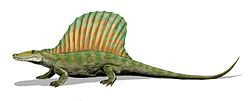| Lamiasaurus Temporal range: | |
|---|---|
| Scientific classification | |
| Domain: | Eukaryota |
| Kingdom: | Animalia |
| Phylum: | Chordata |
| Clade: | Synapsida |
| Clade: | Therapsida |
| Suborder: | † Dinocephalia |
| Family: | † Titanosuchidae |
| Genus: | † Lamiasaurus Watson, 1914 |
| Species: | †L. newtoni |
| Binomial name | |
| †Lamiasaurus newtoni Watson, 1914 | |
Lamiasaurus is an extinct genus of therapsids from the Tapinocephalus Assemblage Zone of the Karoo. It is known from an indeterminate jaw fragment that may be either titanosuchid or anteosaurid. [1]





